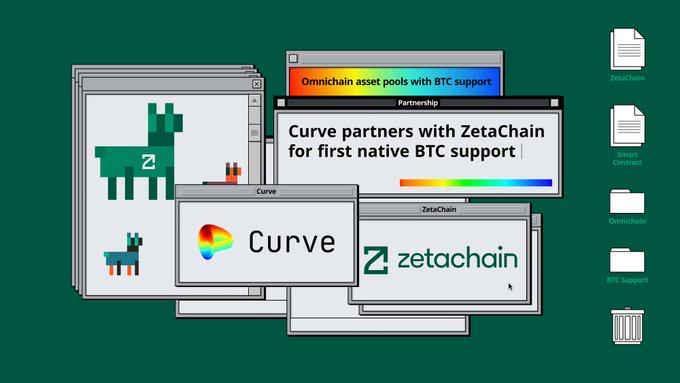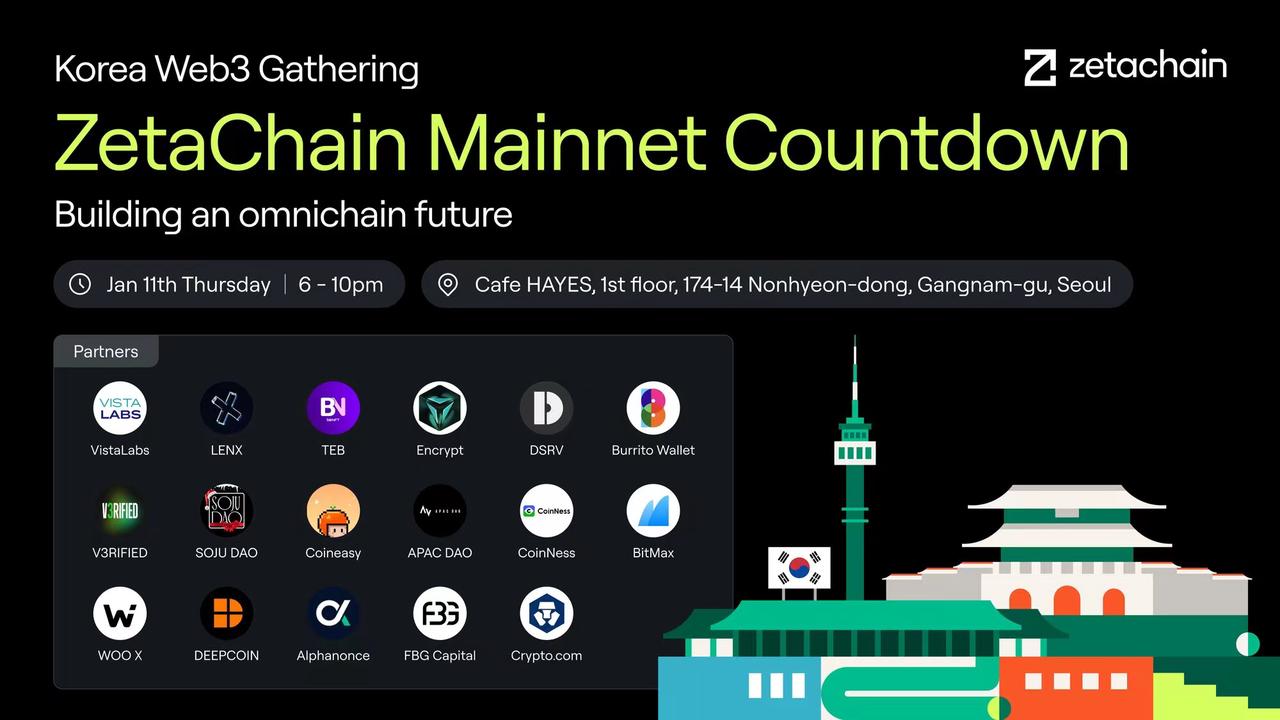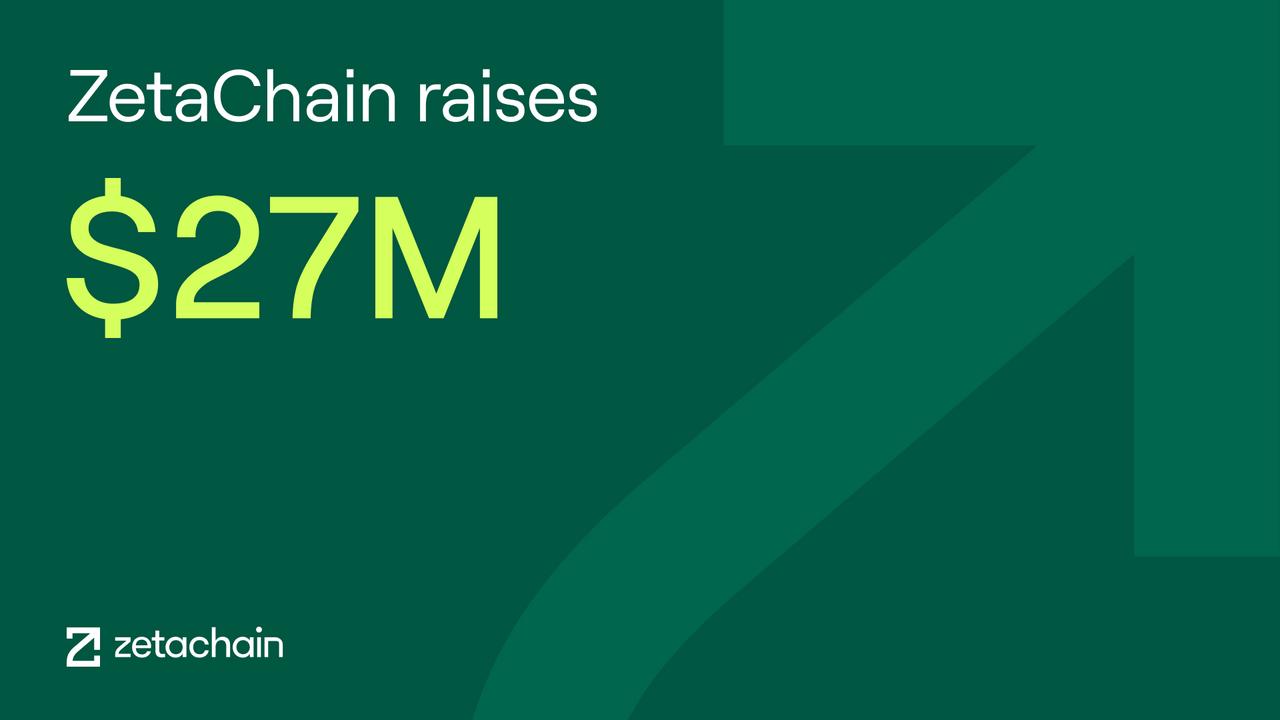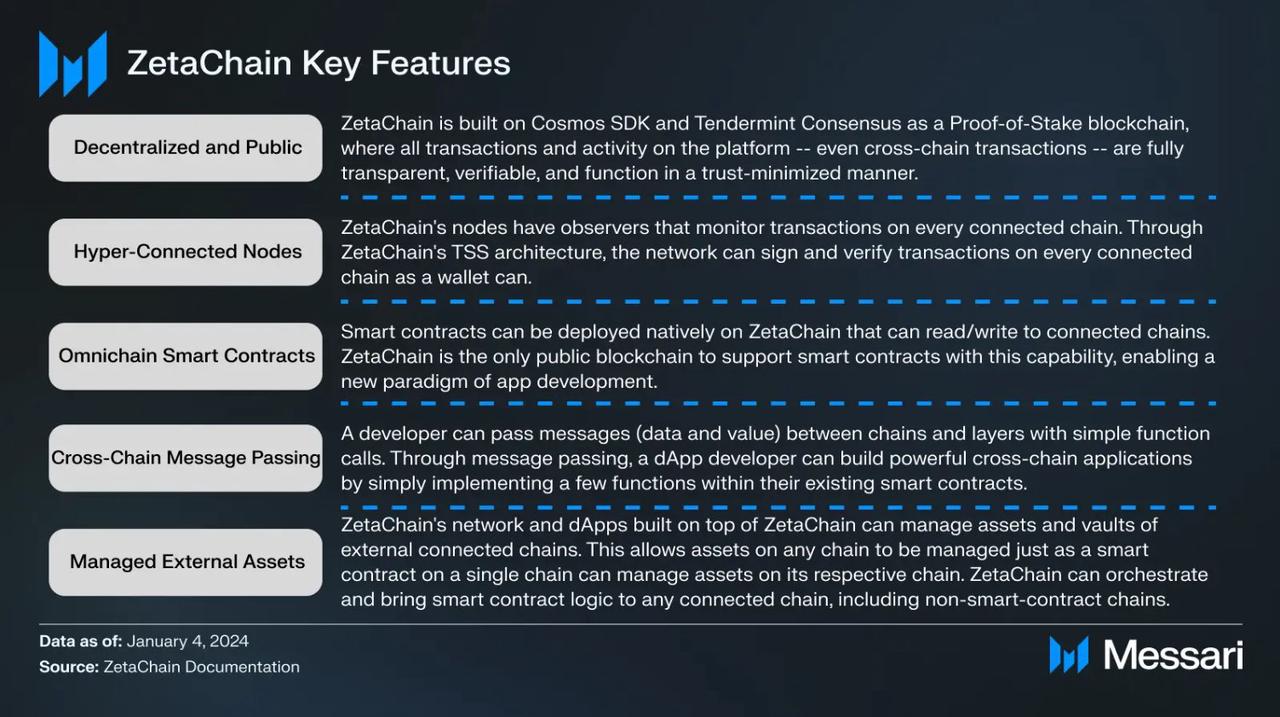In the world of blockchain, security, scalability, and decentralization are often difficult to achieve simultaneously, which is a major pain point for many Layer1 projects. In order to overcome these limitations, a multi-chain ecosystem has emerged, but this has also brought new challenges, such as difficulties in interoperability and high transaction fees. In this context, the emergence of ZetaChain is particularly important. By providing a cross-blockchain smart contract platform, ZetaChain is committed to achieving seamless transfer of value and data between different blockchains. Below is an introduction to the ZetaChain project.
Annual data display project's partial progress, ZetaChain aims to support a more decentralized ecosystem
Unlike previous cross-chain bridges and multi-chain products, ZetaChain has adopted a decentralized strategy, allowing users and developers to freely and securely transfer assets and data between different blockchains. This represents a new attempt of blockchain technology to solve the interoperability problem, and its potential impact on the entire blockchain ecosystem cannot be ignored.
 Curve Finance will integrate ZetaChain to provide native BTC support for cross-chain exchanges and full-chain asset pools
Curve Finance will integrate ZetaChain to provide native BTC support for cross-chain exchanges and full-chain asset pools
Some annual data from ZetaChain shows its activity in the industry. The monthly active users of its testnet dApp ecosystem exceeded 780,000, generating over 14,000,000 cross-chain transactions through testnet dApps on ZetaChain. Additionally, more than 150 dApp partners have integrated on the testnet, over 46,000 dApp contracts have been deployed by developers, and the community has over 1,800,000 members from over 100 countries, covering all major crypto markets. ZetaChain has also achieved native BTC smart contract support for the first time, allowing users to use Bitcoin for DeFi operations or directly from the Bitcoin network itself.
 Ecological map of the ZetaChain project
Ecological map of the ZetaChain project
These data reflect ZetaChain's efforts in blockchain interoperability and some achievements, as well as its potential role in the global blockchain ecosystem.
Sorting out the development history of ZetaChain: The second round of financing raised 27 million US dollars
ZetaChain is an L1 blockchain platform dedicated to achieving cross-chain interoperability. Its notable features include a block time of approximately 5 seconds and finality of transactions without the need for additional confirmations or reorganizations. One of ZetaChain's key innovations is its ability to connect applications with any other application or blockchain, providing a Web3 access point for new and existing users. This interoperability is achieved through full-chain smart contracts, which can read and write data from any other blockchain, including those that do not natively support smart contracts. Additionally, developers can use ZetaChain's Connector feature to send data and value to any chain.
ZetaChain was launched by an anonymous team on December 15, 2021, with team members having backgrounds in Coinbase and Basic Attention Token (BAT). The project's advisory team includes former Coinbase employees, such as Nathalie McGrath, Coinbase's first HR director, and former internal advisor Juan Suarez. On March 9, 2022, the team released the ZetaChain whitepaper and DevNet, and completed the initial seed funding, with the specific amount raised not disclosed. Investors in this round of funding include well-known individuals such as Dan Romero, Sam Rosenblum, John Yi, JD Kanani, and HwiSang Kim.
In August 2023, ZetaChain completed its second round of financing, raising a total of 27 million US dollars, with funding from investors such as Blockchain.com, Human Capital, Vy Capital, Sky9Capital, Jane Street Capital, VistaLabs, CMT Digital, Foundation Capital, LingFeng Capital, and GSR.
 ZetaChain's data performance
ZetaChain's data performance
ZetaChain's testnet was launched in August 2022 and quickly attracted a large number of users. Within the first month of its launch, the number of users reached 150,000. By March 2023, this number had grown to one million, and at the same time, ZetaChain introduced incentives for validators. Although the testnet achieved significant user growth, as of now, ZetaChain has not announced the official release date of the mainnet. These developments reflect ZetaChain's activity and influence in the blockchain field.
Detailed explanation of ZetaChain's technical logic and solutions: A series of innovations in cross-chain interoperability
In the development of blockchain technology, ZetaChain has demonstrated its technical architecture in cross-chain interoperability. Here is a detailed introduction to its core technology:
zEVM: Supports interaction with Ethereum and allows applications from external blockchains to communicate
The zEVM in ZetaChain is an execution layer compatible with the Ethereum Virtual Machine (EVM). This layer not only supports standard EVM functions, such as creating and interacting with smart contracts, but also allows external blockchains to call contracts built on it. The design of zEVM allows for the generation of outbound transactions on blockchains connected to ZetaChain, providing developers on ZetaChain with the ability to create contracts based on zEVM, including standard Solidity contracts and contracts designed for cross-chain message passing.
Full-chain contract architecture: Supports the transfer of digital assets and simplifies cross-chain operations
Full-chain contracts are a major feature of ZetaChain, and once deployed on ZetaChain, they can be connected to external blockchains. These contracts support the transfer of digital assets, following the ZRC-20 token standard. The design of full-chain contracts allows them to be effectively deployed on other blockchain platforms and integrated with chains that do not support smart contracts. Gas fees generated on the target chain are paid in the native token of that chain, simplifying cross-chain operations.
Cross-chain message passing system: Efficient interconnection of data and value messages between various blockchains
ZetaChain also includes a Cross-Chain Messaging (CCM) system as a complement to full-chain contracts. CCM passes data and value messages between blockchains, with ZetaChain acting as an intermediary. CCM contracts pass information between the source and target chains through the ZetaChain Connector API, suitable for applications requiring one-way and asynchronous interaction. This mechanism enhances the cross-chain functionality of existing applications on external chains by paying gas fees in ZETA tokens.
To ensure the security of cross-chain asset transfers, ZetaChain adopts a burn/mint mechanism. Under this mechanism, assets are destroyed on the source chain and regenerated on the target chain, providing security higher than traditional bridging or wrapping methods.
 Highlights of ZetaChain's technology in the Messari report
Highlights of ZetaChain's technology in the Messari report
Through these technical features, ZetaChain provides a practical technical framework for the development of blockchain interoperability, highlighting its efforts in simplifying cross-chain interactions and enhancing security.
Understanding ZetaChain's token economic model and use cases before the mainnet and token launch
ZetaChain is expected to release its mainnet and native token ZETA in the future, although the specific release date has not been determined. In ZetaChain's token economy, the total supply of the native token ZETA is estimated to be 21 billion, based on the airdrop information published by CoinList, which mentions 4,200,000 ZETA accounting for 0.2% of the total token supply. Although the official total supply has not been formally announced, this estimate provides a reference value for understanding the scale of ZetaChain's token economy. The design of the ZETA token primarily focuses on paying network gas fees, executing smart contract operations, and being used for the network's security staking mechanism.
Use cases of the ZETA token:
In the ZetaChain network, the ZETA token will allow validators and token holders to earn rewards through staking, aiming to promote network security and stability. Specific details about staking have not been released yet, but there are basic hardware requirements for running validation nodes, reflecting a focus on maintaining network efficiency and stability.
Supply and distribution of the ZETA token:
Details about the total supply or distribution plan of ZETA have not been publicly disclosed. According to the project team, ZETA will be one of the multi-chain tokens issued across multiple chains and layers, demonstrating its applicability in a multi-chain environment.
Token types in the ZetaChain testnet:
The ZetaChain Athens 3 testnet features various types of tokens, showcasing the diversity of its ecosystem:
Native ZETA token: ZetaChain's native token ZETA is primarily used for paying transaction fees and as a governance token. ZetaChain nodes are built on the Cosmos SDK framework, emphasizing the efficiency and scalability of its network.
Wrapped ZETA (WZETA): ZETA can be converted into WZETA, and this wrapped form of the token is mainly used for liquidity pools within ZetaChain. These tokens can be paired with the native GAS tokens of connected blockchains (e.g., gETH) for increased liquidity and trading convenience.
Tokens from external blockchains: The native GAS tokens (such as gETH, tMATIC, tBNB, and tBTC) from connected blockchains are represented on ZetaChain in the form of ZRC-20 tokens. ZRC-20 is an extension of the ERC-20 standard, allowing users to deposit and withdraw tokens from ZetaChain.
Through this series of token economic structures and ecosystem diversity, ZetaChain is committed to providing a comprehensive framework for cross-chain transactions and interoperability, aiming to facilitate efficient and secure asset circulation and collaboration between different blockchain systems.
ZetaChain will continue to enhance blockchain interoperability, but its future development status still needs attention
ZetaChain is at a critical stage of accelerating its development in the field of blockchain interoperability, facing a complex and dynamic market competition environment. This competition stems not only from the competition between single chains and modular blockchain solutions, such as the advantages of Ethereum's rollup solution in certain aspects over cross-chain ecosystems, but also from multifaceted inherent market competition. In this context, ZetaChain is striving to establish its market position, especially in seamless connectivity and accessibility for Web3 applications.
ZetaChain's infrastructure combines L1 blockchain, Cosmos SDK, and Tendermint consensus algorithm, aiming to provide developers with extensive blockchain connectivity and interaction capabilities through full-chain smart contracts and cross-chain message passing functionality. This capability covers a variety of platforms, including blockchains that do not support smart contracts.
As a proof-of-stake-based chain, ZetaChain drives the decentralization of the network through its native token ZETA. The functionality of ZETA extends beyond protecting network security and paying gas fees; it is also the primary medium for value transfer within the network. As ZetaChain approaches the release of its mainnet, it is expected to play an important role in promoting blockchain interoperability and strengthening the functionality of a broader ecosystem.
However, facing challenges from mainstream adoption, as a relatively new L1 project that has not yet launched its mainnet, ZetaChain faces many typical challenges encountered by blockchain projects. These challenges involve not only technical implementation and ecosystem construction but also competition with existing strong competitors.
ZetaChain's roadmap focuses on increasing user and developer participation, including enhancing chain integrations, expanding interoperability for different dApps and asset types, and providing more comprehensive support tools for full-chain dApp development. At the same time, the ZetaChain team is also working to enhance the security and efficiency of the network to adapt to evolving market demands.
In this competitive process, ZetaChain needs to highlight its uniqueness, such as its architecture, validation mechanism, or transaction efficiency, to differentiate itself from other competitors such as Axelar, LayerZero, and THORChain. The success of ZetaChain will depend on its ability to create unique value in the market, attracting and retaining users and developers.
免责声明:本文章仅代表作者个人观点,不代表本平台的立场和观点。本文章仅供信息分享,不构成对任何人的任何投资建议。用户与作者之间的任何争议,与本平台无关。如网页中刊载的文章或图片涉及侵权,请提供相关的权利证明和身份证明发送邮件到support@aicoin.com,本平台相关工作人员将会进行核查。




